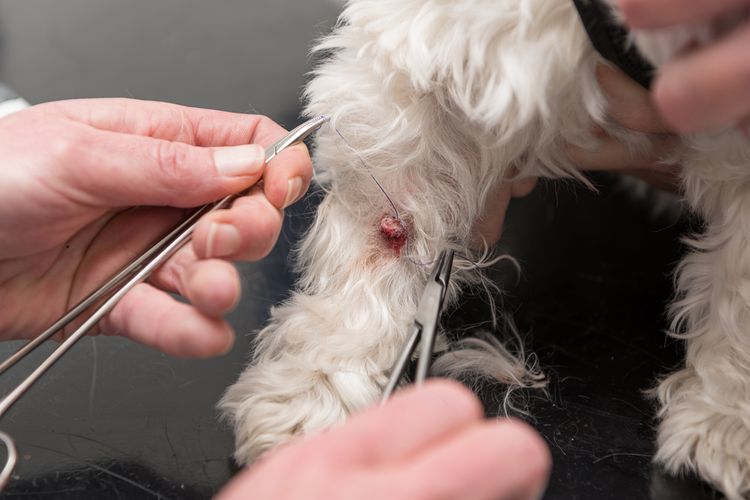What are warts?
Warts are skin growths and can appear individually or in groups on any part of the body. They are usually harmless, but it is often difficult for laypeople to distinguish their symptoms from those of malignant tumors. Read this blog to find out more about skin growths that can occur in dogs and what to look out for.
What are the causes of warts?
Contrary to popular belief, not all wart-like skin lesions in dogs are caused by papillomaviruses. Although many warts, especially in young dogs, are actually caused by the canine papillomavirus, there are also a number of other skin lesions that look similar but are caused by other factors. These causes include allergic reactions, inflammation, injury or even benign and malignant tumors.
It is therefore crucial that a vet carefully examines such skin lesions to determine the exact cause and initiate appropriate treatment. While some warts may disappear on their own, in other cases targeted therapy is necessary, especially if the warts grow, bleed or cause discomfort to the dog. The variety of possible causes emphasizes the need for expert diagnosis to avoid unnecessary risks to the dog's health.
Warts are not always papillomas
Warts, in the classical sense benign tumors, are caused by an overgrowth of the squamous epithelium and have a supporting connective tissue framework. True papillomas occur relatively frequently in dogs. If this connective tissue framework is particularly pronounced, they are referred to as fibropapillomas. However, many of the skin changes that are colloquially referred to as "warts" are not papillomas in the true sense, but various other types of neoplasms. These include sebaceous gland adenomas, nevi or tumors such as basal cell and mast cell tumors.
What types of warts are there?
There are different types of warts that can be distinguished in dogs. One of the more common variants, which is caused by an infection with a DNA virus, is viral papillomatosis, which mainly occurs in young dogs. Other forms, also thought to be caused by papillomaviruses, include pad papillomatosis, cutaneous inverted papillomas and pigmented epidermal plaques, which can potentially degenerate into squamous cell carcinomas. Another form, squamous papilloma, on the other hand, usually occurs as a solitary growth in older dogs.
This variety of manifestations shows how important a precise diagnosis by the vet is in order to correctly classify the type of growth and plan appropriate treatment.

Papillomas of viral origin
Papillomas caused by viruses are contagious and can be transmitted through direct contact between dogs . A weakened immune system can promote the development of such growths. Clinically, these papillomas present as multiple growths, sometimes several centimeters in size, which can appear either flat or pedunculated. They are characterized by a cauliflower-like shape with a smooth or fringed surface. These growths can be injured by chewing, particularly in the oral cavity, which can lead to bleeding. Evidence of the viral origin of a papilloma can be detected histologically. In cases of doubt, further diagnostic methods such as immunohistochemistry, electron microscopy or in-situ hybridization are used.
In young dogs in particular, especially puppies and young dogs, papillomas often occur in the area of the mucous membrane of the mouth and lips, less frequently on the eyelids, ears or other parts of the body. These warts are caused by papova (papilloma) viruses and often manifest themselves in large numbers, which is known as papillomatosis . Papillomas have been shown to be the second most common tumor in dogs under one year of age.
Treatment and prognosis
The prognosis for papillomatosis in dogs is generally favorable. In most cases, the warts disappear spontaneously within three months without the need for treatment. The exact mechanisms that lead to this spontaneous regression are not yet fully understood, but it is thought that the dog's immune system plays a crucial role in controlling the viral infection and regressing the warts.
In rare cases, papillomas can undergo malignant transformation and become malignant. The high prevalence and potential risk of malignancy emphasizes the need for careful monitoring and, if necessary, treatment, especially in young dogs.
In other types of warts
For other types of warts and wart-like skin lesions , the prognosis depends on the underlying cause. Benign neoplasms such as sebaceous adenomas or nevi usually have an excellent prognosis as they are often cosmetic in nature and rarely cause health problems. However, they can be surgically removed if they disturb the dog or grow in sensitive areas such as the eyes or around the mouth.
For tumors such as basal cell or mast cell tumors, which can also appear as wart-like growths, the prognosis varies depending on the tumor type and degree of malignancy. Basal cell tumors are often benign and have a very good prognosis after complete surgical removal. Mast cell tumors, on the other hand, can exhibit more aggressive behavior and are prone to recurrence, which is why early diagnosis and treatment are crucial. In addition to surgical removal, treatment may also include radiotherapy or chemotherapy to improve the prognosis.
Overall , it is important for all wart-like skin lesions to be accurately diagnosed by a vet to ensure the best treatment and prognosis for the affected dog.
Conclusion on warts in dogs
Warts and wart-like skin lesions in dogs can be due to a variety of causes , from viral infections to benign and malignant tumors. While papillomatosis, especially in young dogs, often regresses spontaneously and has a favorable prognosis, it is important to consider each skin lesion individually. Accurate diagnosis by a vet is crucial in order to initiate the correct treatment and minimize potential risks to the dog's health . With careful observation and early intervention where necessary, most of these skin lesions can be treated effectively, resulting in improved well-being for the dog.
Sources and relevant links
Kessler M (2022). Kleintieronkologie. 4., vollständig überarbeitete Auflage. Thieme.



















